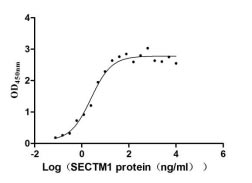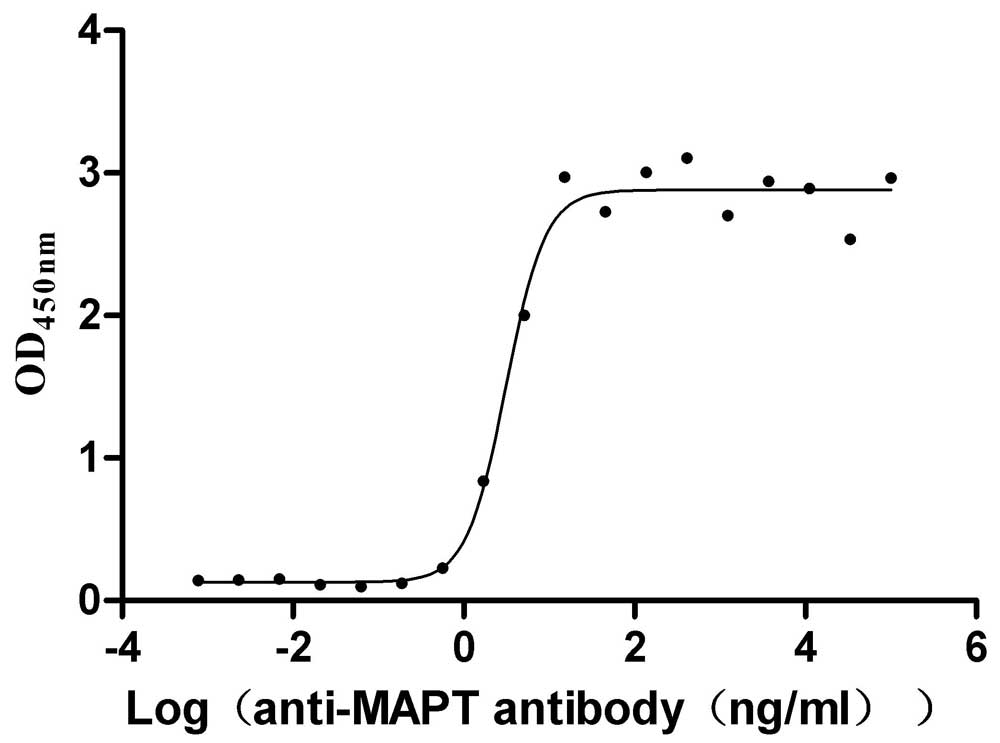Recombinant Human Natural killer cells antigen CD94 (KLRD1), partial
-
货号:CSB-YP615672HU
-
规格:
-
来源:Yeast
-
其他:
-
货号:CSB-EP615672HU
-
规格:
-
来源:E.coli
-
其他:
-
货号:CSB-EP615672HU-B
-
规格:
-
来源:E.coli
-
共轭:Avi-tag Biotinylated
E. coli biotin ligase (BirA) is highly specific in covalently attaching biotin to the 15 amino acid AviTag peptide. This recombinant protein was biotinylated in vivo by AviTag-BirA technology, which method is BriA catalyzes amide linkage between the biotin and the specific lysine of the AviTag.
-
其他:
-
货号:CSB-BP615672HU
-
规格:
-
来源:Baculovirus
-
其他:
-
货号:CSB-MP615672HU
-
规格:
-
来源:Mammalian cell
-
其他:
产品详情
-
纯度:>85% (SDS-PAGE)
-
基因名:
-
Uniprot No.:
-
别名:CD 94; CD94; CD94 antigen; Killer cell lectin like receptor subfamily D member 1; Killer cell lectin-like receptor subfamily D member 1; KLRD 1; KLRD1; KLRD1 protein; KLRD1_HUMAN; KP 43; KP43; Natural killer cells antigen CD94; NK cell receptor; OTTHUMP00000238754; OTTHUMP00000238755; OTTHUMP00000238756; OTTHUMP00000238758; OTTHUMP00000239093
-
种属:Homo sapiens (Human)
-
蛋白长度:Partial
-
蛋白标签:Tag type will be determined during the manufacturing process.
The tag type will be determined during production process. If you have specified tag type, please tell us and we will develop the specified tag preferentially. -
产品提供形式:Lyophilized powder
Note: We will preferentially ship the format that we have in stock, however, if you have any special requirement for the format, please remark your requirement when placing the order, we will prepare according to your demand. -
复溶:We recommend that this vial be briefly centrifuged prior to opening to bring the contents to the bottom. Please reconstitute protein in deionized sterile water to a concentration of 0.1-1.0 mg/mL.We recommend to add 5-50% of glycerol (final concentration) and aliquot for long-term storage at -20℃/-80℃. Our default final concentration of glycerol is 50%. Customers could use it as reference.
-
储存条件:Store at -20°C/-80°C upon receipt, aliquoting is necessary for mutiple use. Avoid repeated freeze-thaw cycles.
-
保质期:The shelf life is related to many factors, storage state, buffer ingredients, storage temperature and the stability of the protein itself.
Generally, the shelf life of liquid form is 6 months at -20°C/-80°C. The shelf life of lyophilized form is 12 months at -20°C/-80°C. -
货期:Delivery time may differ from different purchasing way or location, please kindly consult your local distributors for specific delivery time.Note: All of our proteins are default shipped with normal blue ice packs, if you request to ship with dry ice, please communicate with us in advance and extra fees will be charged.
-
注意事项:Repeated freezing and thawing is not recommended. Store working aliquots at 4°C for up to one week.
-
Datasheet :Please contact us to get it.
相关产品
靶点详情
-
功能:Immune receptor involved in self-nonself discrimination. In complex with KLRC1 or KLRC2 on cytotoxic and regulatory lymphocyte subsets, recognizes non-classical major histocompatibility (MHC) class Ib molecule HLA-E loaded with self-peptides derived from the signal sequence of classical MHC class Ia and non-classical MHC class Ib molecules. Enables cytotoxic cells to monitor the expression of MHC class I molecules in healthy cells and to tolerate self. Primarily functions as a ligand binding subunit as it lacks the capacity to signal.; KLRD1-KLRC1 acts as an immune inhibitory receptor. Key inhibitory receptor on natural killer (NK) cells that regulates their activation and effector functions. Dominantly counteracts T cell receptor signaling on a subset of memory/effector CD8-positive T cells as part of an antigen-driven response to avoid autoimmunity. On intraepithelial CD8-positive gamma-delta regulatory T cells triggers TGFB1 secretion, which in turn limits the cytotoxic programming of intraepithelial CD8-positive alpha-beta T cells, distinguishing harmless from pathogenic antigens. In HLA-E-rich tumor microenvironment, acts as an immune inhibitory checkpoint and may contribute to progressive loss of effector functions of NK cells and tumor-specific T cells, a state known as cell exhaustion. Upon HLA-E-peptide binding, transmits intracellular signals through KLRC1 immunoreceptor tyrosine-based inhibition motifs (ITIMs) by recruiting INPP5D/SHIP-1 and INPPL1/SHIP-2 tyrosine phosphatases to ITIMs, and ultimately opposing signals transmitted by activating receptors through dephosphorylation of proximal signaling molecules.; KLRD1-KLRC2 acts as an immune activating receptor. On cytotoxic lymphocyte subsets recognizes HLA-E loaded with signal sequence-derived peptides from non-classical MHC class Ib HLA-G molecules, likely playing a role in the generation and effector functions of adaptive NK cells and in maternal-fetal tolerance during pregnancy. Regulates the effector functions of terminally differentiated cytotoxic lymphocyte subsets, and in particular may play a role in adaptive NK cell response to viral infection. Upon HLA-E-peptide binding, transmits intracellular signals via the adapter protein TYROBP/DAP12, triggering the phosphorylation of proximal signaling molecules and cell activation.; (Microbial infection) Viruses like human cytomegalovirus have evolved an escape mechanism whereby virus-induced down-regulation of host MHC class I molecules is coupled to the binding of viral peptides to HLA-E, restoring HLA-E expression and inducing HLA-E-dependent NK cell immune tolerance to infected cells. Recognizes HLA-E in complex with human cytomegalovirus UL40-derived peptide (VMAPRTLIL) and inhibits NK cell cytotoxicity.; (Microbial infection) May recognize HLA-E in complex with HIV-1 gag/Capsid protein p24-derived peptide (AISPRTLNA) on infected cells and may inhibit NK cell cytotoxicity, a mechanism that allows HIV-1 to escape immune recognition.; (Microbial infection) Upon SARS-CoV-2 infection, may contribute to functional exhaustion of cytotoxic NK cells and CD8-positive T cells. On NK cells, may recognize HLA-E in complex with SARS-CoV-2 S/Spike protein S1-derived peptide (LQPRTFLL) expressed on the surface of lung epithelial cells, inducing NK cell exhaustion and dampening antiviral immune surveillance.
-
基因功能参考文献:
- an early response by KLRD1-expressing Natural killer cells may control influenza infection. PMID: 29898768
- it is not clear if high expression of CD94 on peripheral blood NK cells is related to abnormal activity of endometrial NK cells. PMID: 24975965
- Synergistic inhibition of natural killer cells by the nonsignaling molecule CD94. PMID: 24082146
- Studies indicate that HLA-E interacts with CD94/NKG2 receptors expressed mainly on the surface of natural killer (NK) cells, thus confining its role to the regulation of NK-cell function. PMID: 22576308
- Loss of CD94 is associated with rheumatoid arthritis. PMID: 22102879
- increased expression on natural killer cells in women with recurrent spontaneous abortion after IVIG therapy PMID: 19811464
- human CD56(bright) NK cells progress through a continuum of differentiation that ends with a CD94(low)CD56(dim) phenotype. PMID: 19897577
- Conservation and variation in human and chimpanzee CD94 genes PMID: 11751968
- A critical role of CD94-dependent MHC-I recognition for the regulation of IFN-gamma production and target lysis was demonstrated. PMID: 12149421
- TCR specificity dictates CD94/NKG2A expression by CTL. PMID: 12387742
- CD94 gene expression is regulated by distal and proximal promoters that transcribe unique initial exons specific to each promoter, resulting in two species of transcripts--the previously described CD94 mRNA and a novel CD94C mRNA. PMID: 14607929
- Aberrant expression of natural killer (NK) receptors CD94/NKG2A may have an impact on the magnitude and direction of dendritic cell activation of T cells under pathological conditions, such as chronic hepatitis C virus infection. PMID: 15528343
- A CD94 alternatively spliced transcript paired with an NKG2B isoform may contribute to the plasticity of the natural killer cell immunological synapse by insuring an adequate inhibitory signal. PMID: 16237464
- Cytolytic activity levels of purified CD94-expressing cells from 7-day cultures with FK506 were much higher than those from 7-day cultures without FK506. PMID: 16378079
- results indicate that the SNPs of the inhibitory receptor CD94/NKG2A and its haplotypes, as well as its ligand HLA-E, are associated with Behcet's disease immune systems PMID: 17767552
- identified molecular characteristics of an aggressive subset of pediatric patients with AML through a prospective evaluation of CD56+ neural cell adhesion molecule (NCAM) and CD94 expression PMID: 18323797
- Uncommon endocytic and trafficking pathway of the natural killer cell CD94/NKG2A inhibitory receptor is described. PMID: 18363778
- Under the influence of interleukin-12 stimulation, CD94/NKG2A is transiently inducible in natural killer (NK) cells bearing the homologous CD94/NKG2C-activating receptor, providing a potential negative regulatory feedback mechanism. PMID: 19124726
- In this work, the glycan ligands of NKG2D and CD94 for the first time were resolved. PMID: 19303396
- NKG2D and CD94 bind to heparin and sulfate-containing polysaccharides. PMID: 19555665
显示更多
收起更多
-
亚细胞定位:Cell membrane; Single-pass type II membrane protein.
-
组织特异性:Expressed in NK cell subsets (at protein level). Expressed in memory/effector CD8-positive alpha-beta T cell subsets (at protein level). Expressed in melanoma-specific cytotoxic T cell clones (at protein level). Expressed in terminally differentiated cyto
-
数据库链接:
HGNC: 6378
OMIM: 602894
KEGG: hsa:3824
STRING: 9606.ENSP00000338130
UniGene: Hs.562457
Most popular with customers
-
Recombinant Human Secreted and transmembrane protein 1 (SECTM1), partial (Active)
Express system: Mammalian cell
Species: Homo sapiens (Human)
-
Recombinant Macaca mulatta Microtubule-associated protein tau (MAPT) (Active)
Express system: Mammalian cell
Species: Macaca mulatta (Rhesus macaque)
-
Recombinant Dog Angiopoietin-2 (ANGPT2) (Active)
Express system: Mammalian cell
Species: Canis lupus familiaris (Dog) (Canis familiaris)
-
Recombinant Mouse Gastric inhibitory polypeptide receptor (Gipr), partial (Active)
Express system: Mammalian cell
Species: Mus musculus (Mouse)
-
Recombinant Mouse CUB domain-containing protein 1 (Cdcp1), partial (Active)
Express system: Mammalian cell
Species: Mus musculus (Mouse)
-
Recombinant Human Interleukin-2 (IL2) (Active)
Express system: Mammalian cell
Species: Homo sapiens (Human)
-
Recombinant Human Serotransferrin(TF) (Active)
Express system: Mammalian cell
Species: Homo sapiens (Human)
-
Recombinant Human Gastric inhibitory polypeptide receptor(GIPR),partial (Active)
Express system: Mammalian cell
Species: Homo sapiens (Human)




















